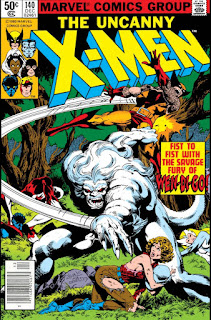In the Blackwood story, the Wendigo is described only vaguely:
...a sort of great animal that lives up yonder," he jerked his head northwards, "quick as lightning in its tracks, an' bigger'n anything else in the Bush, an' ain't supposed to be very good to look at...
Ithaqua from Derleth's The Thing That Walked on the Wind is also described with broad strokes:
...I threw that startled glance into the sky and saw that the stars had been blotted out, I thought that the ‘cloud’ which had obscured the sky looked curiously like the outline of a great man. And I remember, too, that where the top of the ‘cloud’ must have been, where the head of the thing should have been, there were two gleaming stars, visible despite the shadow, two gleaming stars, burning bright-like eyes!
In the June 1944 issue of Famous Fantastic Mysteries, the Wendigo is illustrated as a giant antlered beastman, which perhaps is the original inspiration for the antlered Wendigo.
 |
| Matt Fox, 1944 |
The cover of the Valdemar edition of collected Blackwood stories, is illustrated with a bizarre antlered beast that looks like it came straight out of Kingdom Death.
 |
| The Wendigo and Other Strange and Macabre Tales, 2020 |
My first exposure to the Wendigo however, came through Marvel comics, which portrayed the Wendigo as a large furry white anthropoid monster.
 |
| John Byrne, X-Men |
This type of Wendigo can be seen from the likes of Crocodile Games.
 |
| WarGods of Hyperborea |
More often than not though, the Wendigo is thought of nowadays as a skeletal antlered monster that is part beast, part man.
 |
| Peter Johnston for AE-WWII |
 |
| Pathfinder 2nd ed. |
 |
| Dark Heaven Legends 03673 |
 |
| Pet Semetary, 2019 |
 |
| Hannibal, S2 2014 |
Personally, I find popular culture versions of the Wendigo such as the Stag Man from Hannibal more reminescent of the Horned King from the The Chronicles of Prydain, or the Horned God Cerunnos (when not muddling matters further with other types of imagery).
 |
| Cover by Evaline Ness |
 |
| Cerunnos, Nationalmuseet |
 |
| Hannibal, S2 2014 |
Algonquian descriptions of the Wendigo or Windigo (ᐄᐧᐦᑎᑯᐤ) portray a corpse-like being which can be several times taller than a human.
Depictions of Wendigos by First Nations artists are also quite different from mainstream images.
 |
| Cover art by Norval Morrisseau |
 |
| Carl Ray, 1971 |
 |
| Jackson_Beardy, 1967 |
I agree with the notion from Incidental Mythology that modern iterations of the Wendigo continue to build on pop culture depictions, appropriating and obscuring the original material.
In any event, I'm ambivalent to the antlered Wendigo, and don't have any miniatures of them (although I am rather partial to the difficult to find AE-WWII miniature which would make a good undead broo).
The miniatures I do have are from the Windwalker faction of Cthulhu Wars by Petersen Games. In the game, Ithaqua and Wendigos are different entities. The former being ranked among The Great Old Ones, while the later are a servitor race.
I have a translucent blue version of the Ithaqua figure. The standard version is in pale blue plastic like the Wendigo figure.
The Wendigo is the hairy humanoid type, but doesn't look too compatible with 1/72 scale figures since they are said to be roughly human-sized in the game. This makes complete sense of course, since it is scaled to human figures that are at least 32mm tall.
The set also contains Ice Age Tokens which make for good terrain pieces, as well as Gnoph-Keh, another servitor race.
For whatever reason, the Gnoph-Keh are typicially described as six-legged polar bears with a horn sticking from the forehead.
The Cthulhu Wars Gnoph-Keh however, fit the game image of mysterious monsters that loom in the snowy wastes, while watching their surroundings silently and ominously.
Sandy Petersen says the design of the Gnoph-Keh turned out rather underwhelming, but I like their somewhat goofy, slack-jawed look.
Interestingly enough, Clark Ashton Smith also uses the name Gnophkeh to describe a race of hairy, Ithaqua-worshipping creatures. They are described as cannibalistic (which I think is a misappellation, since he probably meant they eat humans rather than other Gnophkeh), which makes me think that they are not different from the Wendigo.
























Hi Eric, thank you for your study in Cthulhu mythos, and the search for 1/72 compatible figures as always. I've been playins Cthulhu role playing game since the v1 by Sandy Petersen, it's still my favourite nowadays, although I'm also fond of Mansion of Madness - have you tried this game yourself ?
ReplyDeleteHi Phil,
ReplyDeleteI haven't played Mansion of Madness, but I'm a long time CoC player. Cthulhu Wars is good for a change of pace every now and then, but I'm not much of a boardgame player.